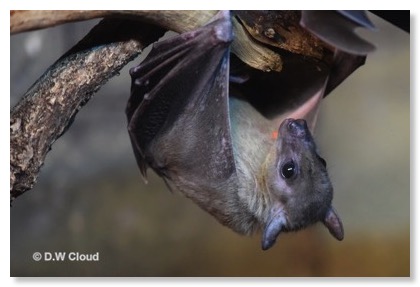The Bat
by D.W. Cloud

“These bats are like miniature spy planes, bristling with sophisticated instrumentation. Their brains are delicately tuned packages of miniaturized electronic wizardry, programmed with the elaborate software necessary to decode a world of echoes in real time. Their faces are often distorted into gargoyle shapes that appear hideous to us until we see them for what they are, exquisitely fashioned instruments for beaming ultrasound in desired directions” (Dawkins, The Blind Watchmaker, p. 24).
Because of his willful spiritual blindness, Dawkins can write about sophisticated instrumentation, delicately tuned packages, elaborate software, and exquisitely fashioned instruments, and then turn around and claim that it was all evolved by blind forces of chance.
Adam Pitman remarks:
“This sonar is a marvellous discriminator: in a bat-swarm, in cave or night air, a bat can know its own sound among thousands of mobile neighbours, detecting its own signals even if they are 2000 times fainter than background noises. It can ‘see’ prey, such as a fruit-fly, up to 100 feet away by echo location and catch four or five in a second. And this whole auditory system weighs a fraction of a gram! Ounce for ounce, watt for watt, it is millions of times more efficient and more sensitive than the radars and sonars contrived by man” (Pitman, Adam and Evolution, p. 219).
The bat’s rate of pulse changes. The brown bat pulses at about 10 per second as it is cruising, but this quickens when it detects an insect and begins to intercept it. The pulses can reach 200 per second. This means that the bat’s brain is capable of performing incredible amounts of mathematical calculations almost instantly.
Some bats have muscles that enable it to dampen its ear mechanism while it is transmitting its radar pulses. “The muscles contract immediately before the bat emits each outgoing pulse, therefore switching the ears off so that they are not damaged by the loud pulse. Then they relax so that the ear returns to maximal sensitively just in time for the returning echo. This send/receive switching system works only if split-second accuracy in timing is maintained. The bat called Tadarida is capable of alternately contracting and relaxing its switching muscles 50 times per second, keeping in perfect synchrony with the machine gun-like pulses of ultrasound” (Dawkins, pp. 27, 28).
Many bats produce a sound that changes pitch. It is basically a high-pitched shriek that sweeps down about an octave. This technique is used in modern radar and is called “chirp radar.” This gives the bat even more sophisticated ability to distinguish between returning echoes. Since its emissions begin at a higher pitch, its brain knows that if a returning echo is a higher pitch it is from a more distant object. “When an echo from a distant object finally arrives back at the bat, it will be an ‘older’ echo than an echo that is simultaneously arriving back from a near object. It will therefore be of higher pitch. When the bat is faced with clashing echoes from several objects, it can apply the rule of thumb: higher pitch means farther away” (Dawkins, p. 29).
Consider the amazing intelligence, though, that is required for a bat to apply such a “rule of thumb”!
The bat is found in the fossil record perfectly formed from the very beginning. The following quotes are from scientists who were interviewed for the book Evolution: The Grand Experiment (volume 1) by Dr. Carl Werner:
“There’s a ten-million-year period of early mammal evolution where you would guess that there’d be some sort of bat precursor, but once again, nothing. Bingo, they just show up” (Dr. Gary Morgan, Assistant Curator of Paleontology, New Mexico Museum of Natural History and Science and a specialist in bat evolution).
“We have no evidence for this evolution. The bats appear perfectly developed in the Eocene” (Dr. Gunter Viohl, Curator of the Jura Museum in Eichstatt, Germany).


